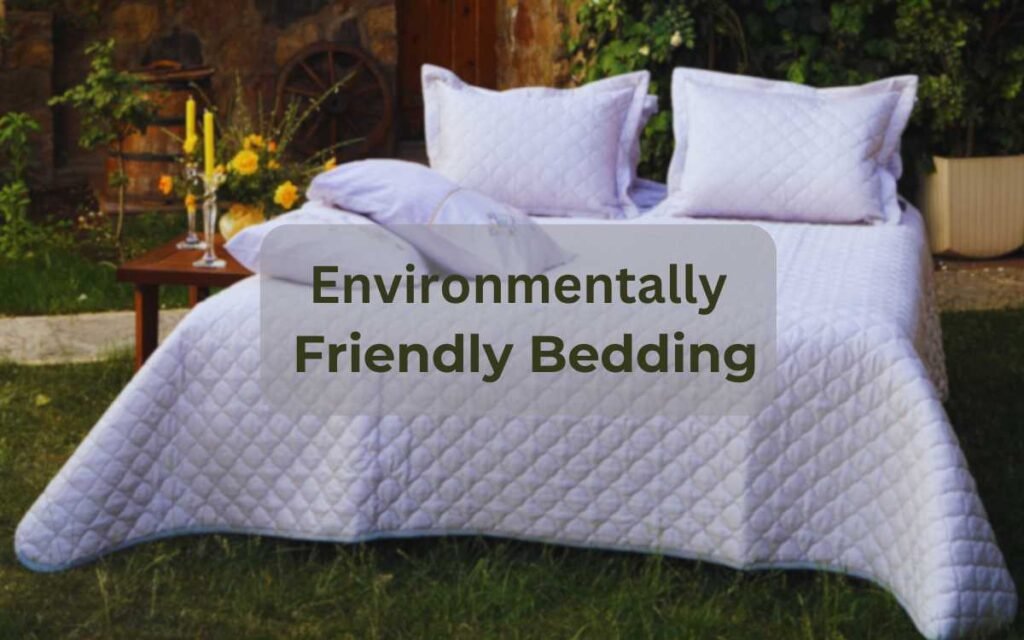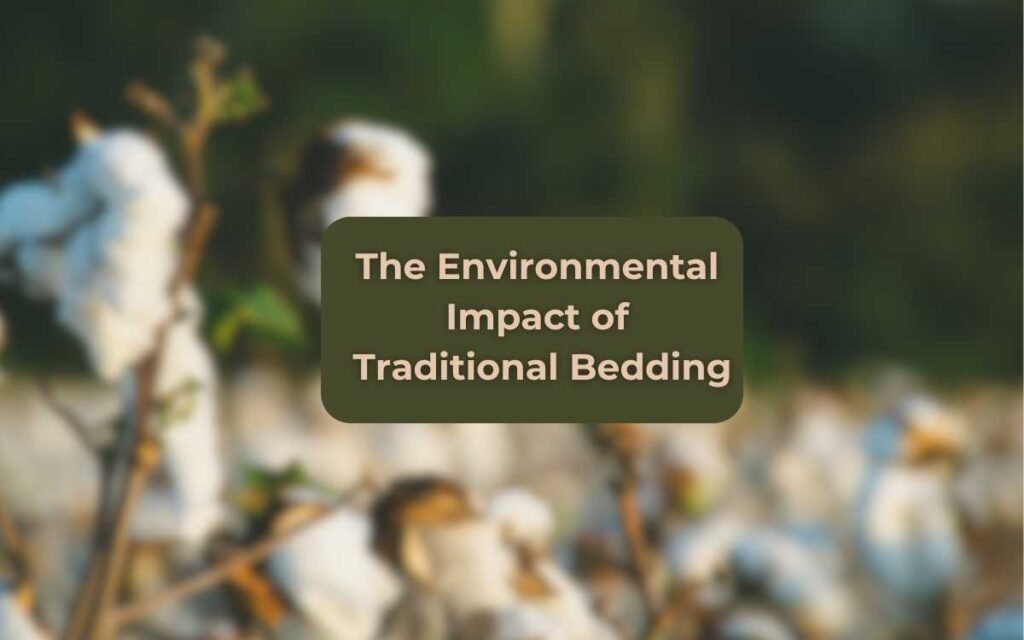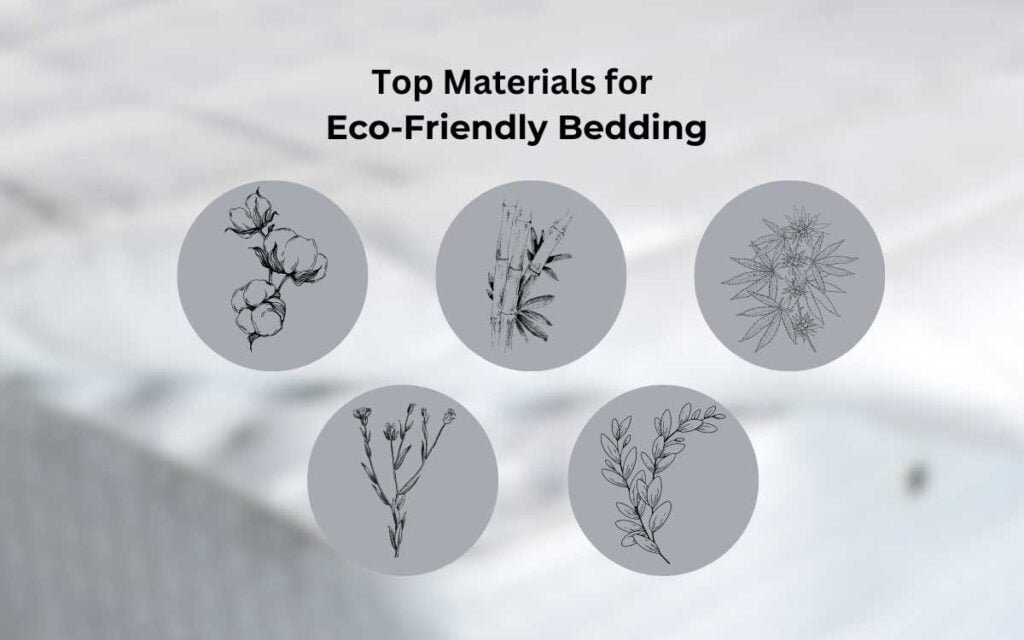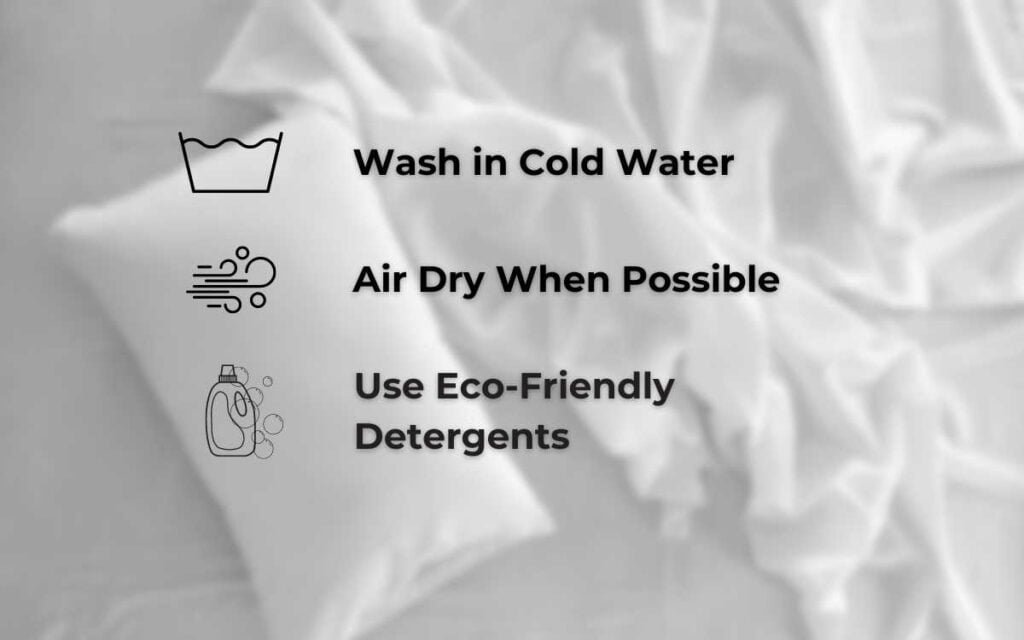
- Introduction
- The Environmental Impact of Traditional Bedding
- Top Materials for Eco-Friendly Bedding
- How to Choose the Right Sustainable Bedding
- Best Practices for Maintaining Eco-Friendly Bedding
- Top 5 Brands for Environmentally Friendly Bedding in 2024
- DIY Eco-Friendly Bedding Solutions
- Customer Reviews: Real Experiences with Sustainable Bedding
- Bottom Line
Introduction
When it comes to making eco-friendly choices, bedding often gets overlooked. But, using “Environmentally friendly Bedding” can help the planet and your comfort.
Let’s dive into everything you need to know about eco-friendly bedding. We’ll cover its environmental impact, the best materials, and brands.
Then, you can make an informed choice for a greener bedroom.
The Environmental Impact of Traditional Bedding

Did you know that cotton and synthetic bedding have a big impact? They are traditional materials. Cotton farming, for example, uses 24% of the world’s insecticides even though it only covers 2.5% of agricultural land.
Synthetic fibers like polyester are made from petroleum which is a non-renewable resource. It also adds to microplastic pollution.
Also, making regular bedding uses harmful chemicals and lots of water. For instance, producing a single cotton t-shirt takes about 2,700 liters of water! By switching to environmentally friendly bedding, you can significantly reduce your ecological footprint.
Top Materials for Eco-Friendly Bedding

When it comes to eco-friendly bedding, the materials you choose are crucial for reducing your environmental impact while ensuring a good night’s sleep.
Here’s a closer look at some of the best sustainable options available:
1. Organic Cotton
Organic cotton is a popular choice for eco-conscious consumers. Unlike conventional cotton, organic cotton is grown using natural methods that maintain soil health and reduce chemical runoff.
Benefits:
- Eco-Friendly Farming: Organic cotton farming practices help conserve water and reduce pollution.Soft and Breathable: It’s known for its softness and breathability, making it comfortable for all types of sleepers.
- Reduced Exposure to Chemicals: Since it’s grown without harmful chemicals, it’s a great option for those with sensitive skin or allergies.
Considerations:
Price: Organic cotton can be more expensive than conventional cotton due to the more sustainable farming practices.
Availability: Ensure you look for certified organic cotton to avoid blends or misleading claims.
2. Bamboo
Bamboo is a rapidly renewable resource, making it an excellent choice for eco-friendly bedding. It grows quickly and doesn’t require pesticides or much water, making it a more sustainable option compared to traditional crops.
Benefits:
- Fast Growth: It can grow up to 35 inches in a single day, making it a highly renewable resource.
- Minimal Water Use: It requires significantly less water than cotton or other crops.
- Naturally Antimicrobial: Ithas natural antimicrobial properties that can help reduce bacteria and odor.
Considerations:
- Processing: The process of turning bamboo into fabric (viscose or rayon) can involve chemicals. Look for bamboo bedding that is processed using eco-friendly methods, such as closed-loop systems.
3. Hemp
Hemp is a versatile and sustainable material that has been used for centuries. It’s incredibly durable, making it a long-lasting choice for bedding. Hemp plants grow quickly and require minimal water, which contributes to their environmental benefits.
Benefits:
- Durable and Long-Lasting: Hemp fibers are stronger than cotton and become softer with each wash.
- Low Water Consumption: Hemp requires about half the water of cotton, making it a more sustainable choice.
- Natural Resistance: Hemp is naturally resistant to pests, reducing the need for pesticides.
Considerations:
- Texture: Hemp can be a bit coarser than other fabrics, but it softens over time.
- Price: Like organic cotton, hemp bedding can be pricier due to its sustainable production.
4. Linen
Linen is made from the flax plant and is known for its low environmental impact. It’s a natural, biodegradable fiber that has been used for centuries in clothing and bedding.
Benefits:
- Biodegradable: Linen is made from the flax plant, which is entirely biodegradable.
- Breathable and Moisture-Wicking: Linen has excellent breathability and moisture-wicking properties, making it ideal for hot climates.
- Longevity: Linen is highly durable and becomes softer and more comfortable with each wash.
Considerations:
- Wrinkling: Linen tends to wrinkle easily, which might not be ideal for everyone’s taste.
- Care: It requires some special care to maintain its appearance and longevity.
5. Tencel (Lyocell)
Tencel, also known as Lyocell, is a relatively new fabric made from wood pulp, usually sourced from eucalyptus trees. The production process is designed to be environmentally friendly, with a closed-loop system that recycles water and solvents.
Benefits:
- Eco-Friendly Production: The closed-loop process used to make Tencel ensures that the water and solvents are recycled, minimizing waste.
- Soft and Smooth: Tencel is incredibly soft and smooth, often compared to silk in terms of feel.
- Temperature Regulation: It’s highly absorbent and helps regulate body temperature, which can improve sleep quality.
Considerations:
- Cost: Tencel can be more expensive than conventional bedding materials.
- Availability: As a newer material, it might not be as widely available as cotton or bamboo.
How to Choose the Right Sustainable Bedding

Choosing eco-friendly bedding doesn’t have to be complicated. By keeping a few key factors in mind, you can make a decision that’s both good for the environment and perfect for your personal comfort.
Here’s a simple guide to help you find the right sustainable bedding for your needs:
1. Look for Certifications
When shopping for sustainable bedding, certifications can help you verify that the products are genuinely eco-friendly and ethically produced.
Look for the following certifications:
GOTS (Global Organic Textile Standard): This certification ensures that the bedding is made from organic fibers and produced in an environmentally and socially responsible manner. GOTS-certified products meet strict criteria for organic farming, processing, and fair labor practices.
OEKO-TEX Standard 100: This certification verifies that the bedding is free from harmful chemicals and is safe for human health. It’s a good indicator that the product has been tested for harmful substances and meets high safety standards.
These certifications can give you peace of mind that your bedding is both sustainable and safe.
2. Consider the Material
Choosing the right material is crucial for both comfort and environmental impact. Think about your personal preferences and the climate you live in:
- Bamboo: Ideal for hot sleepers, bamboo bedding is breathable and moisture-wicking. Its natural properties help keep you cool and comfortable, making it a great choice if you tend to get warm at night.
- Linen: Perfect for humid or warm climates, linen is highly breathable and has excellent moisture-wicking properties. It helps keep you cool and dry, which is especially beneficial in hotter weather.
- Organic Cotton: Versatile and soft, organic cotton works well in a variety of climates. It’s breathable and comfortable, making it a good all-round choice if you prefer a natural fiber.
- Hemp: Durable and resistant to pests, hemp is suitable for those who prefer a more rugged, long-lasting fabric. It’s also a good choice if you’re looking for something that becomes softer with each wash.
- Tencel (Lyocell): Known for its silky feel and temperature-regulating properties, Tencel is a great option if you want a luxurious, comfortable fabric that also helps keep you cool.
3. Check Durability
- Durability: is a key factor in sustainable bedding. High-quality, durable products last longer and reduce the need for frequent replacements, which helps minimize waste.
- Quality: Look for well-made bedding with strong seams and high-quality materials. Durable bedding will withstand regular use and laundering, making it a more sustainable choice in the long run.
- Longevity: Choose materials known for their durability. For example, hemp and linen are particularly long-lasting and can endure many years of use. Investing in durable bedding means you’ll get more value out of your purchase and contribute less to landfill waste.
- Maintenance: Consider how easy it is to care for the bedding. Some materials require special care or laundering, while others are low maintenance. Opt for bedding that fits your lifestyle and cleaning preferences.
Best Practices for Maintaining Eco-Friendly Bedding

To get the most out of your eco-friendly bedding and ensure it lasts for years to come, it’s important to follow some key maintenance practices. Here’s how you can keep your sustainable bedding in top shape:
1. Wash in Cold Water
Washing your bedding in cold water is one of the simplest ways to reduce your environmental footprint and extend the life of your fabric. Here’s why:
- Energy Savings: Heating water accounts for a significant portion of the energy used in washing clothes. By using cold water, you lower your energy consumption and reduce your carbon footprint.
- Fabric Preservation: Cold water is gentler on fabrics, helping to maintain their color and texture. This means your bedding will look and feel new for longer.
Tip: Always check the care label on your bedding for any specific washing instructions to ensure you’re following the manufacturer’s recommendations.
2. Air Dry When Possible
Air drying your bedding is an excellent way to save energy and protect your fabrics. Here’s how it benefits both you and the environment:
- Energy Conservation: Using a dryer consumes a lot of electricity. By air drying, you reduce your energy use and lower your utility bills.
- Fabric Care: Air drying helps prevent wear and tear that can occur in the dryer. It also reduces the risk of shrinkage and damage, keeping your bedding in great condition
Tip: If you don’t have space for air drying, consider using a low-heat setting on your dryer to minimize energy use and fabric stress.
3. Use Eco-Friendly Detergents
Choosing the right detergent is crucial for maintaining the integrity of your eco-friendly bedding. Opt for products that are both effective and environmentally friendly:
- Biodegradable: Biodegradable detergents break down naturally and don’t leave harmful residues in the environment. They are a great choice for reducing pollution and supporting eco-friendly practices.
- Non-Toxic: Avoid detergents with harsh chemicals or artificial fragrances. These can irritate your skin and contribute to environmental pollution. Look for detergents labeled as free from dyes, phosphates, and synthetic additives.
Tip: You can also make your own detergent using natural ingredients like baking soda, washing soda, and essential oils for a custom, eco-friendly solution.
Additional Tips
- Regular Cleaning: Regularly wash your bedding to remove dirt and allergens, but avoid over-washing as it can lead to faster wear.
- Proper Storage: Store your bedding in a cool, dry place to prevent mold and mildew. Avoid exposing it to direct sunlight for extended periods, which can cause fading.
- Spot Clean: For minor stains, spot cleaning with a gentle, eco-friendly cleaner can be more effective and less damaging than frequent full washes.
By following these best practices, you’ll not only help maintain the quality of your eco-friendly bedding but also contribute to a more sustainable lifestyle.
Top 5 Brands for Environmentally Friendly Bedding in 2024

When it comes to choosing eco-friendly bedding, several brands stand out for their commitment to sustainability and quality.
Here are the top five brands for environmentally friendly bedding in 2024:
1. Boll & Branch
Overview
Boll & Branch is renowned for its luxurious organic cotton bedding. The brand prioritizes ethical sourcing and fair labor practices, ensuring that every product is made with care for both people and the planet.
Sustainability Features
- Organic Cotton: All products are made from 100% certified organic cotton, grown without harmful pesticides or synthetic fertilizers.
- Ethical Manufacturing: Boll & Branch partners with fair-trade certified factories, ensuring fair wages and safe working conditions for workers.
- Eco-Friendly Practices: Their packaging is made from recycled materials, and they use eco-friendly dyes.
Why Choose Them
If you’re looking for bedding that combines comfort with a strong commitment to sustainability, Boll & Branch offers a luxurious option that doesn’t compromise on environmental values.
2. Brooklinen
Overview
Brooklinen is known for its stylish and high-quality bedding options. They offer a range of eco-friendly materials, making it easy to find bedding that fits both your taste and your values.
Sustainability Features:
- Eco-Friendly Materials: Brooklinen offers bedding made from organic cotton, bamboo, and linen, all of which are sourced responsibly.
- Sustainable Production: They focus on reducing waste and energy use in their manufacturing processes.
- Transparency: Brooklinen provides detailed information about their sourcing and manufacturing practices.
Why Choose Them
Brooklinen’s combination of stylish designs and sustainable materials makes it a great choice for those who want to look good while doing good.
3. Coyuchi
Overview
Coyuchi specializes in organic cotton and linen bedding, with a strong emphasis on environmental responsibility. They offer a range of products that are both beautiful and sustainable.
Sustainability Features:
- GOTS-Certified Products: Coyuchi’s bedding is certified by the Global Organic Textile Standard (GOTS), ensuring it meets strict environmental and social criteria.
- Natural Dyes: They use natural dyes and avoid harmful chemicals in their products.
- Closed-Loop Systems: Coyuchi is committed to minimizing waste and conserving resources in their production processes.
Why Choose Them
Coyuchi is ideal if you’re looking for bedding with a focus on organic materials and ethical production practices, coupled with timeless designs.
4. Avocado Green Mattress
Overview
Known primarily for their eco-friendly mattresses, Avocado Green Mattress also offers a range of organic cotton and linen bedding. Their commitment to sustainability extends across their entire product line.
Sustainability Features:
- Organic Materials: Bedding is made from certified organic cotton and linen, ensuring no harmful chemicals are used.
- Eco-Friendly Manufacturing: Avocado Green uses sustainable manufacturing practices and is a certified B Corp, which means they meet high standards of social and environmental performance.
- Carbon Neutral: The company is carbon-neutral, offsetting its emissions through various environmental initiatives.
Why Choose Them
Avocado Green Mattress is a top choice for those who want to invest in bedding from a company with a strong overall commitment to environmental responsibility.
5. Parachute
Overview
Parachute is known for its high-quality bedding made from sustainable materials. Their products combine luxury with a commitment to responsible manufacturing practices.
Sustainability Features:
- Sustainable Materials: Parachute offers bedding made from organic cotton, linen, and Tencel, all of which are sourced with environmental considerations in mind.
- Ethical Production: They ensure fair labor practices and responsible manufacturing processes.
- Eco-Conscious Packaging: Parachute uses eco-friendly packaging materials to minimize waste.
Why Choose Them
Parachute’s focus on premium materials and responsible production makes it a great option for those looking to blend luxury with sustainability.
DIY Eco-Friendly Bedding Solutions

If you’re a DIY enthusiast and passionate about sustainability, creating your own eco-friendly bedding can be both a fun project and a meaningful way to reduce your environmental impact. Here are some creative and eco-friendly DIY ideas to transform your bedding:
1. Upcycle Old Fabrics
Give new life to old clothes or linens by turning them into fresh bedding items. Upcycling not only helps reduce waste but also allows you to create unique, personalized pieces.
How to Do It:
- Gather Materials: Collect old t-shirts, sheets, or even worn-out curtains that are still in good condition.
- Design and Cut: Plan out what you want to make—whether it’s pillowcases, quilt covers, or even a bedspread. Use a pattern or improvise based on the fabric you have.
- Sew and Assemble: If you’re not confident in your sewing skills, start with simple projects like pillowcases or patchwork quilts. You can find plenty of online tutorials for guidance.
Benefits:
- Reduces Waste: By reusing existing materials, you help keep textiles out of landfills.
- Customizable: You can choose patterns and colors that perfectly fit your style and décor.
2. Use Natural Dyes
Customizing your bedding with plant-based dyes is a fantastic way to create unique and eco-friendly textiles. Natural dyes are derived from plants, fruits, and vegetables, and they don’t contain harmful chemicals.
How to Do It:
- Choose Your Dyes: Common natural dyes include beet juice (for red), turmeric (for yellow), and spinach (for green). You can experiment with various natural sources to get different colors.
- Prepare the Fabric: Pre-wash your fabric to remove any residues and prepare it for dyeing.
- Dyeing Process: Follow a basic dyeing tutorial. Typically, you’ll simmer your chosen dye source in water, add a mordant (like vinegar or salt) to help the dye set, and then soak your fabric in the dye bath until you reach the desired color.
- Rinse and Dry: After dyeing, rinse your fabric in cool water until the water runs clear, then hang it to dry.
Benefits:
- Chemical-Free: Natural dyes are free from synthetic chemicals, making them better for the environment and your health.
- Unique Designs: Each dyeing process produces unique patterns and colors, so your bedding will be one-of-a-kind.
3. Make Homemade Detergents
Creating your own eco-friendly laundry detergent is a great way to ensure your bedding stays clean without exposing it to harsh chemicals. Homemade detergents are effective, biodegradable, and gentle on both fabrics and the environment.
How to Do It:
- Gather Ingredients: You’ll need basic ingredients like baking soda, washing soda, and castile soap. If you want, you can add essential oils.
- Mix Ingredients: Combine 1 cup of baking soda, 1 cup of washing soda, and 1 cup of grated castile soap. For a fragrance boost, add 10-15 drops of essential oil (such as lavender or lemon).
- Store Properly: Keep your homemade detergent in an airtight container. Depending on the size and dirtiness, use 1-2 tablespoons per load of laundry.
Benefits:
- Eco-Friendly: Homemade detergents reduce reliance on commercial products that often contain harmful chemicals.
- Cost-Effective: Making your own detergent is usually more affordable than buying commercial options.
- Gentle on Fabrics: Natural ingredients are less likely to damage or wear out your bedding.
Additional Tips
- Pillowcase Protectors: Consider making or buying organic pillowcase protectors to extend the life of your pillows and maintain cleanliness.
- Patchwork Quilts: Create patchwork quilts from fabric scraps or old clothes. They’re not only eco-friendly but also add a personal touch to your bedroom.
Fabric Paint: Use fabric paint or markers made from natural ingredients to add designs or personalize your bedding.
Customer Reviews: Real Experiences with Sustainable Bedding

When it comes to eco-friendly bedding, customer reviews provide valuable insights into the real-life benefits and occasional drawbacks of these products. Here are some genuine reviews from Amazon and other eco-friendly bedding websites, showcasing the experiences of satisfied customers:
Boll & Branch
Amazon Customer Review:
Rating: 5 Stars
“So soft that I feel like my legs are moving in water =). Sheets do keep cool. I slept like an innocent lamb the first week we had them. NOTE: we ordered the Split King sizes for our dual adjustable bed. The sheets are ABSURDLY oversized, YET the gussets don’t disengage the mattress, even when there is a lot of adjusting of each bed throughout the night. So, while the top sheet is large, it is nice to have plenty of sheet for your shoulders and feet! And even my dog looks forward to snoozing on the sheets! BRAVO!”
Highlights:
- Softness: The sheets are incredibly soft, providing a luxurious feel.
- Cooling Effect: They help keep you cool throughout the night.
- Adjustable Fit: Despite being oversized, the sheets stay in place on adjustable beds.
- Pet-Friendly: Even pets enjoy the comfort of these sheets.
Coyuchi
Coyuchi Website Review:
Reviewer: Jessica (Verified Buyer)
Rating: 5 Stars
“Love them! But Gulf bleeds. It was time to change our towels, I had been looking at those towels for a while but they are much more expensive than the organic cotton towels from another brand that I had been using and couldn’t justify the splurge. We stayed at a hotel in Point Reyes that had them and loved them. I got the Dusty Coral and Gulf on sale, we love the pairing. They are soft but dry well right away, they do air dry faster than the other ones I had. We like the sizes of the hand towels. The only con is the Gulf leaves fine dust everywhere and bleeds on other colors.”
Highlights:
- Softness and Quick Drying: The towels are soft to the touch and dry quickly.
- Air Dry Efficiency: They air dry faster than other brands.
- Color Bleeding: The Gulf color tends to bleed and leave dust, which might be a drawback.
Parachute
Parachute Website Review:
Reviewer: Anonymous
Rating: 5 Stars
“Was desperately looking to replicate a sheet set that I had been purchasing for years that had been discontinued from another retailer, and I did! Parachute percale will not disappoint you! I’m so glad I found this very luxurious percale! Treat yourself!”
Highlights:
- Luxurious Feel: The percale sheets from Parachute offer a luxurious sleeping experience.
- Satisfaction: Customers who loved their previous bedding found Parachute’s percale sheets to be a perfect replacement.
Bottom Line
Switching to environmentally friendly bedding is a simple yet impactful way to make a positive change for both yourself and the planet. By choosing the right materials, brands, and maintenance practices, you can enjoy a healthier, more eco-conscious sleep environment. So, sleep well and green!






